|
|
Post by trappnman on Feb 4, 2012 13:12:56 GMT -6
been thinking of going to them next year on my mink and rat sets-probably sticking with cable on coon, but maybe not.
so for those that have some experience with them, what are the pros and cons?
some questions:
should the bottom end of rod be fastend down either by stake, or sticking in creek bottom?
if not, is the rod just laying there on the surface, or is top part angled, or can angle be set/changed?
Whats the best lock?
Whats the optimum diameter, and what lengths seem to "fit most"?
How do the above apply to rats/mink, & coon?
with coon, with bottoms not staked, whats the % of live coon?
any other things I should know, or be aware of?
|
|
|
|
Post by schippergreg on Feb 4, 2012 22:25:54 GMT -6
I ran them for years and they worked great for me. Can be a pain to haul though. I made mine 8ft out of 3/8 rebar. Just speared them into the mud. The locks were 3/4 in square tube with a piece of 2-3 in flat stock welded on with a j-hook and a quick clip to attach the trap.
|
|
|
|
Post by thebeav2 on Feb 4, 2012 23:18:43 GMT -6
I made mine 8' long and had two staking points one at the bank end and the second staking point 16" from the end one. Then I had a cable clamp on the deep end for a stop. This removable cable clamp allowed me to remove the trap for storage. Lots of times I would leave the drowning rod behind at the end of the season Or I would stash the rods during my pre season work.
With the two staking points you never had to get In the water to secure the deep end and by removing the second stake you could just rotate the rod back to the bank. In most cases the angle of the bank allowed the rod to be at the bottom of the creek. But even If It didn't the coon would be out In the water and would soon wear out and drown. I wouldn't use anything less then 3/8 re bar for coon. Anything less like a cold roll type rod would be twisted up like a pretzel by a coon. If I were beaver trapping I would be using 1/2 rebar.
|
|
|
|
Post by trappnman on Feb 5, 2012 12:00:43 GMT -6
what about the synthetic rods?
|
|
|
|
Post by thebeav2 on Feb 5, 2012 13:50:55 GMT -6
Don't know never tried them.
I would assume they cost more and It would be more expensive to attache staking points to those types of rods.
Re bar works for me.
|
|
|
|
Post by mustelameister on Feb 5, 2012 15:14:37 GMT -6
Steve, I've gone away from the 10' drowner rods that I ran up on the Baraboo River. Took me a full season last year to figure out they weren't much use down here, and after thinking about things for awhile last summer, I wound up cutting most of 'em in half. Had the finished product ready in time for the late August trapper ed class here and a fellow instructor has since adopted this drowning technique and claims, as I do, there isn't any better out there for drowning mink, 'coon and 'rats. I think you're going to like this. The only fella that won't like it will be the Beav, 'cause he already knows everything and probably tried this 50 years ago but since it didn't work for him back then he's since poo-pooed it and will more than likely die without even trying it.  So here's that pic I ran on the other thread of my #1 winter 'coon set. Look in the bottom left-hand corner and what do you see? Yuppers, that's a 5-foot stick of 3/8" rerod just peeking out of the water. Between there and the PVC pipe is a length of 3/32" GAC, drowner lock S-linked to the trap, and an S-link on either end. The 1/2" stake on the bank end runs through the S-link as well as the 3/8" terminal rerod. Nothing really new here, right? Old school in fact. 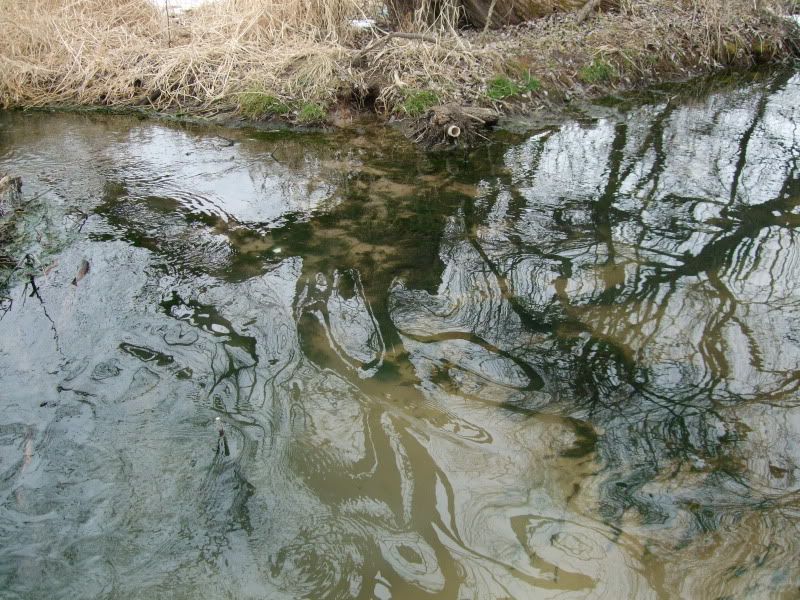 The difference is, of course, the 5' stick of 3/8" rerod as a terminal stake. I run all drowners most of the time. I like the flexibility of a multiple-day check. The problem for me has been anchoring the terminal end. Got anything here from mud to sand. Don't want to carry rock around, cement blocks, and having had one hernia already, don't want to get into yanking up earth anchors. So why five-foot, right? Here's the deal. 5-foot rerod stake has a nut smashed down tight on it, about 16" or so from one end. A fella could weld one there, but I'm no welder. Next to it is a steel pipe that is just a wee bit larger in diameter, inside, than is the 3/8" rerod. 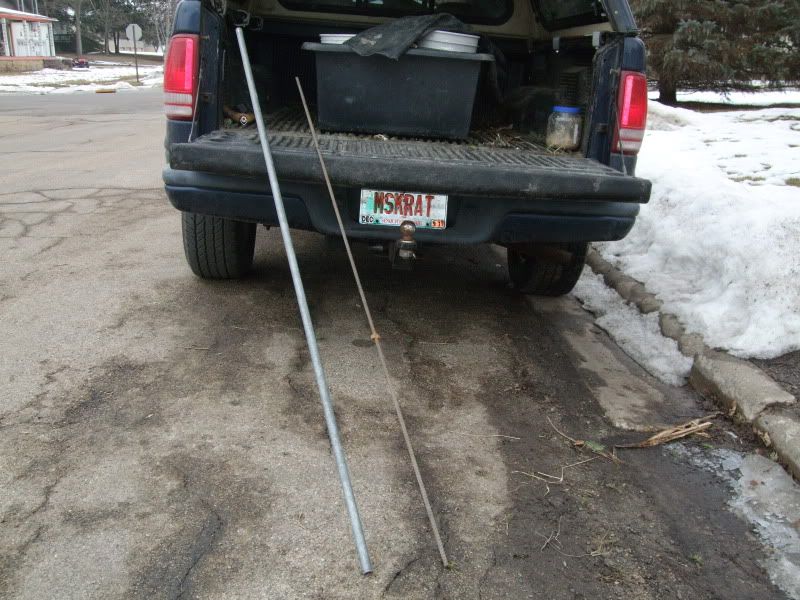 The steel pipe becomes a driver for the 5-foot rerod. Simply run the end of the rerod, opposite the smashed nut, through the S-link on the terminal end of the drowner cable. Either walk this out from the bank, or push off in the boat and when the cable is tight, sink it down into the bottom. Now slip the steel pipe over the top of the rerod, and slide it down 'till it meets the nut. Now lift and strike down sliding that pipe inside the 16" or so of rod above the nut, driving the rerod down into the bottom. You can keep on driving 'till the rod disappears if you've got that kind of soft bottom. If so, you'll need to give a little slack in the cable before you commence to pounding. Here's how I ran all my DPs this season. 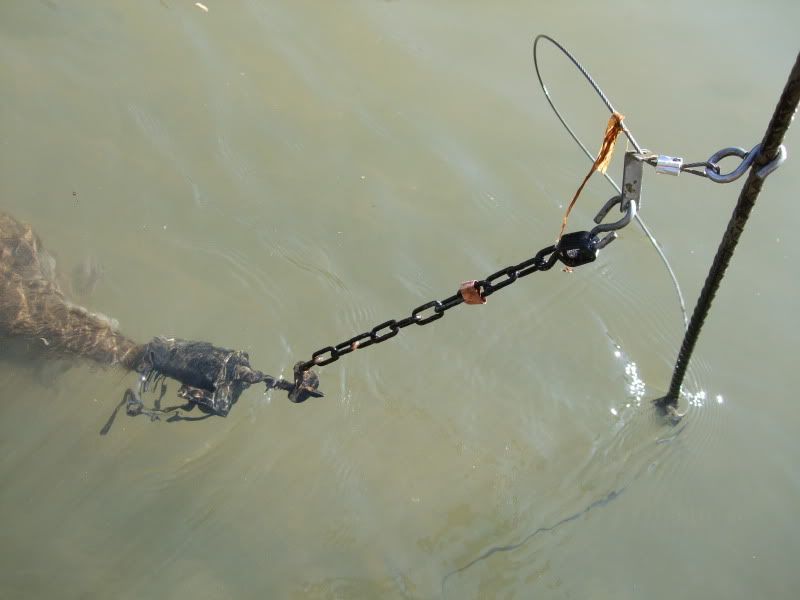 The beauty of this method is of 4-parts: 1) easy to set, 2) terminal end will not budge, 3) easy to carry half a dozen into an area or in a boat or canoe you can load up as many as you feel comfortable handling, and 4) easy to lift! Simply get vertical above the set and lift straight up on the drowner cable. No matter the substrate, the rerod pops right up if pulled straight up. Nope, doesn't work on rock bottoms. But I don't have 'em. Now I did leave some of my old drowner rods 10-feet long. I've got a few places where it drops right off from the bank. Same scenario. I sit in the front of the boat and push off after anchoring the bank end, pay out the drowner cable, when it gets tight slide the 10-foot stick through the S-link and hammer down in the boat. Here's a pic of just such a spot with two traps. 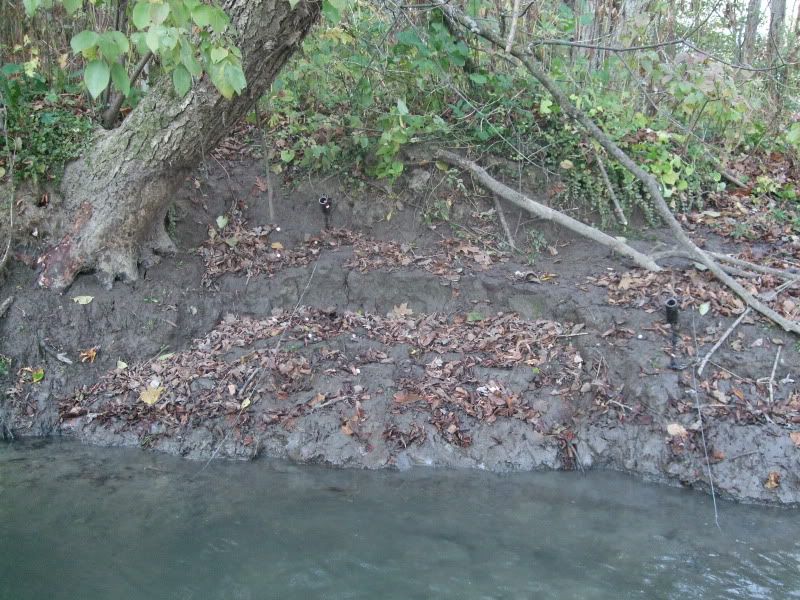 I'm still working with the fluctuating water levels down here. Not setting out deep enough initially sometimes results in this scenario: 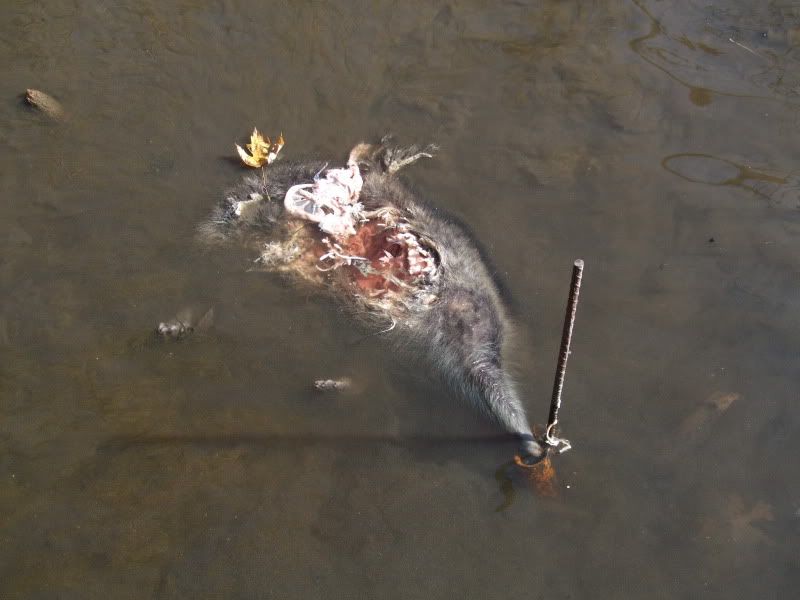 Just need to run more cable out. Another downer is when you're driving the rerod in and you don't know it, but you're driving it into a sunken log.  Did that more than a couple of times this past season. Just bent the rod over flat and left it there. No way you're gonna pull it out. Well, that's it. It's a good system. And best of all, it works for me. |
|
|
|
Post by thebeav2 on Feb 5, 2012 23:22:41 GMT -6
I think you're going to like this. The only fella that won't like it will be the Beav, 'cause he already knows everything and probably tried this 50 years ago but since it didn't work for him back then he's since poo-pooed it and will more than likely die without even trying it.  You do what you want. I see no need to to anchor the deep end . The coon Is going out on the rod and Is not coming back. It will wear It's self out and die. No need to wade out In deep water to anchor your slide wire or wade out to untangle the coon or other critter. Why would I have to haul around 5' re bar stakes to anchor the deep end of a slide cable? 2 feet of water Is plenty deep to drown a coon so a 18" T bar stake shoved Into the bottom will do the job. A struggling coon that can't can't get It's feet on the bottom won't exert a lot of power at that deep end stake so lighten the load no need for a 5' stake In 2' of water. And I can't remember that last time I set up a drowning rod or a slide wire for rats or mink. Large traps like the #2 or 1.75 will drown them In 5" of water. But I'm sure muskrat has got this system down pat so no need to argue the point.  MY advise Is to try different systems and see what works for you In your situation. I have been at this a long time and I have tried many different systems and what I'm using now works for me. |
|
|
|
Post by braveheart on Feb 6, 2012 6:07:12 GMT -6
I use the 1/2 rebar for beaver on a snare or a trap.They are all 8ft. fits in my truck better and easier to work with.No need to walk in deep water to retrieve or set trap .Best thing I have ever used they are dead and out of site.The bars get bent pretty bad 1/2 in. for beaver only one stake at the top other end pushed in the mud.
|
|
|
|
Post by trappnman on Feb 6, 2012 7:07:39 GMT -6
my goal on water is to 100% drown everything
2 feet for coon and 5 inches on rats, and esp 5 inches on mink, doesn't do that for me.
and all my coon sets are cabled, and a great deal of my rat/mink sets are #2 double longsprings- a very heavy trap.
and for rats I want at least a foot of water, for mink even more and coon far more.
but, beav as mentioned many times drowning isnt a concern for him, as long as hes legal setting in water it doesn't matter to him
but it matters to me on 3 day checks- I want everything down and out of sight. and to do that even close to 100%, I want far deeper water than 5" or 2'.
I'd love to set by those standards, but for me, its just not in the cards, cause the results, for me, are not what I want.
|
|
|
|
Post by thebeav2 on Feb 6, 2012 7:50:44 GMT -6
And how many critter DON"T go down the rod or cable? Just saying nothing works to perfection.
#2 double long springs for rats and mink? I doubt very much that a mink or rat could even drag a trap of that size out Into deep water. Now In setting your traps adjacent to deep water or on the edge of a rat hut where the rat or mink just roll off Into deep water would work. But that sure limits your choice of locations on most streams.
Not saying traps of that size aren't good rat and mink traps because they are but my experience shows me rats and mink can be drowned In very shallow water.
|
|
|
|
Post by trappnman on Feb 6, 2012 8:36:45 GMT -6
I had one coon that didn't go down the cable this year- and that was my fault to a degree- it was a flat bank set up with a pipe, where I put a log behind the pipe to somewhat force a coon around into the water, and one coon there, got the cable (or chain hard to tell when I got there) around the log.
but really, cables with either a staked bottom or a heavy weight is as close to foolprooof as you can get- IF the water is deep enough. I'm ok with cables on coon- works well for me, and the bottom side isn't a problem- I have either clay type bottoms where its easy to get a bottom stake in (sometimes very hard to remove!) or rocky bottoms where I love using wire cages w/rocks. I do have a couple locations close to road, and there its easy enough to carry in a few weights-
I don't have any problems as you described with #2 double longsprings and all I trap anymore is small, grassy type creeks. It doesn't limit locations in any way, and I can't think of a scenario where I used a 1.5 either long spring or coil, where I couldn't have just as well set a #2 dls.
I have a lot, perhaps the majority, of sets where there is a shallow ledge, often times more than a foot, sometimes two, until it drops off into deep water and both rats and mink have no problems moving the trap into deeper water. And then wrap it around the stake. And I get mink every year, that have a catch circle on the bank, before finally drowning.
I wish I could get by with 5" of water, and not to hold you too close to that 5" but say under a foot, is too shallow for me. not to say I occasionally don't try such setups, cause I still do if no other choice.
I do use an occasional stoploss in must set situations- but then you often have a rat above water- tainting them more on a 3 day check, plus having that rat exposed to predators.
And having stoploss with me, makes the temptation to high.....
meaning I bypass locations that simply are too shallow to drown and keep under water.
Had one set like that that stood out this past year- water at the set 2-3 inches, then went to 8-10 inches for 10 feet or more.
but a good little feedbed, so I set it up, and caught I think 11-12 rats there. Most were drowned, but some were not. Lucky, no wringoffs, but 3-4 alive in a #2 double longspring, with no land access.
I most likely err on the side of caution. While nothing is 100%, by setting rat and esp mink traps in at least 2 feet of water and coon at least 4, I can make it as foolproof as possible- anything less than that and I know, that I've now dropped that "sure thing" percentage.
going back to rods-
I now stake my rat/mink traps in a bunch of different ways- I'll tie off to logs, I'll push a stake flush into the bottom, I use weights, I use coyote drags, I use fiberglass fence stakes.
My thought was to change to one system for those-
rods-
so that every mink trap, would be 100% coon proof.
but it sounds like everyone is using rebar- and not sure I want to carry that much rebar to outfit evry water trap I set.
I thought so many were going to carbon rods or somesuch?
|
|
|
|
Post by trappnman on Feb 6, 2012 8:40:50 GMT -6
mike- I can see how that system would be absolutely perfect from a boat or where weights weren't an option.
|
|
|
|
Post by cflann on Feb 6, 2012 10:27:44 GMT -6
Steve,
I've got a handfull of those carbon drowning rods that that guy from MN (is it Tim Kressel or something like that) sells and I have to say anyone who would bad-mouth those has never used them. They absolutely are the best invention in drowning rods out there.
Now, I'm not debating drowning rods over cable here. That's your preference and they both have pros and cons. But if you want to talk about and compare drowning rods, there really is no comparison to metal. They are sooooo much lighter and easier to work with.
Are there drawbacks to the carbon drowning rods? Sure, cost. That's it! They cost more to outfit yourself. But once you have them, I don't see how they would ever fail. I've used rerod for coon drowners in 3/8 and 1/2 inch and have had large coon bend both. Not going to happen with the carbon rods.
The only thing I can complain about on my carbon drowning rods is they probably are a bit longer than I need. They're 8' I think and I could probably get by with 6'
|
|
wbg
Demoman...
  
Posts: 182
|
Post by wbg on Feb 6, 2012 10:33:47 GMT -6
Tman, I wonder why you say ''especially Mink'' I find it much more likely to have trouble drowning shallow water rats then mink. I run extended checks without drowners and have no trouble with shallow water mink. Over the years it has worked out to approx 2 live mink per 100, and I believe that they are all caught shortly before I arrived. I think this is a very acceptable ratio. This is with almost all 1.5 coil's, long springs and jumps. I do tend to use the jumps in deeper or faster water.
|
|
|
|
Post by trappnman on Feb 6, 2012 10:33:53 GMT -6
I'd like to hear, see more Chris-
what are we looking at for cost? how are you setting them up? staking bottom somehow (either by pushing into mud, or otherwise)?
and now that you bought some- could they be made at home just as well as buying?
|
|
|
|
Post by trappnman on Feb 6, 2012 10:55:24 GMT -6
wbg- I've seen it twice this year, and in years past, where a big male mink, rear leg caught, in shallow water simply doesn't drown IF allowed land access, which most of my traps do. I've tossed them into the water watched them sink to the bottom, their nose comes up, and they swim, even with a heavy trap on them, back to shore. Deep water, esp with current, seems to eliminate this- more effort, more options, whatever, don't know- but do know, that when I get a live mink, its in marginally deep water, where I set thinking he SHOULD drown here......but
yes, most will eventually keep returning to the water and eventually drown. but, if you have weedy grassy shores, you up your chance of loosing mink, and I do get a toe or two every year, from a trap tangled up in grass.
you lessen the chance of that occurring, in my opinion, by having drowning water, for any animal, thats over their head when standing in the water, or, with a trap on the rear foot extended in the water.
I find it true that mink and coon, do not go willingly into the night- that in shallower water, its a long trip if just set up to a single stake. Longer not down and out, the longer things can go wrong.
just my opinion, of course- and as I said, due to water use conditions here (meaning winter stream fishing), I tend to err on the side of caution.
|
|
|
|
Post by blackhammer on Feb 6, 2012 14:09:45 GMT -6
One problem with big traps and shallow water is while the animal will be expired.It is laying in shallow water for predators to rip up.
Never used drowning rods but the carbon ones intrigue me.Would like something for spring beaver that was fast and simple.Will they hold beaver with just a stake on the bank?
|
|
|
|
Post by thorsmightyhammer on Feb 6, 2012 20:31:23 GMT -6
I use carbon drowners for beaver almost exclusively if I set a foot hold.
Ony time I use cable drowners for beaver anymore is when 8 to 10 foot isnt enough length.
stick the deep end in the mud and anchor the top end.
I know alot of guys who use rebar on the same system.
I think a guy will see people selling drowning rods made out of fiberglass rods pretty quick.
should be cheaper.
|
|
|
|
Post by cflann on Feb 7, 2012 8:51:53 GMT -6
Yeah, I kind of agree with Steven. Wonder when someone will market the fiberglass models.
Steve, to be honest, I can't remember what I paid for those carbon drowner rods. Steven, do you remember?
I just stick the terminal end in the bottom of the water, put a t-bar stake at the top and am on my way. With these bendable carbon rods, you can easily bend them slightly downward when setting if you need to or you want to and they bounce right back into shape.
The lock that Kressel uses is really nice quality too. It's more cable drowner lock shaped and not the usual lock made of a piece of square tubing. Although those locks work fine on chain and rebar, I don't know how well they'd do on the carbon rods.
I think if you had a supplier of the carbon rods you certainly could make them yourself. All Kressel does is crimp down a piece of metal piping on the rod to secure the terminal tackle.
I'll try to remember to take some pics of the rods, but I'll be on the road for a few days this week.
|
|
|
|
Post by trappnman on Feb 7, 2012 9:14:26 GMT -6
how often do you use them, when the bottom isn't stuck into the mud, when its just "out there"? Because thats going to be a factor in overall use for me- deep water, where the rod goes into the water but isn't fastened down?
coon mainly for the above question, I could see on strickly rats and mink, probably wouldn't matter
|
|